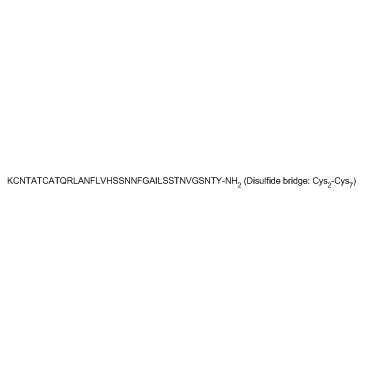Structures of rat and human islet amyloid polypeptide IAPP(1-19) in micelles by NMR spectroscopy.
Ravi Prakash Reddy Nanga, Jeffrey R Brender, Jiadi Xu, Gianluigi Veglia, Ayyalusamy Ramamoorthy
Index: Biochemistry 47 , 12689-12697, (2008)
Full Text: HTML
Abstract
Disruption of the cellular membrane by the amyloidogenic peptide IAPP (or amylin) has been implicated in beta-cell death during type 2 diabetes. While the structure of the mostly inert fibrillar form of IAPP has been investigated, the structural details of the highly toxic prefibrillar membrane-bound states of IAPP have been elusive. A recent study showed that a fragment of IAPP (residues 1-19) induces membrane disruption to a similar extent as the full-length peptide. However, unlike the full-length IAPP peptide, IAPP(1-19) is conformationally stable in an alpha-helical conformation when bound to the membrane. In vivo and in vitro measurements of membrane disruption indicate the rat version of IAPP(1-19), despite differing from hIAPP(1-19) by the single substitution of Arg18 for His18, is significantly less toxic than hIAPP(1-19), in agreement with the low toxicity of the full-length rat IAPP peptide. To investigate the origin of this difference at the atomic level, we have solved the structures of the human and rat IAPP(1-19) peptides in DPC micelles. While both rat and human IAPP(1-19) fold into similar mostly alpha-helical structures in micelles, paramagnetic quenching NMR experiments indicate a significant difference in the membrane orientation of hIAPP(1-19) and rIAPP(1-19). At pH 7.3, the more toxic hIAPP(1-19) peptide is buried deeper within the micelle, while the less toxic rIAPP(1-19) peptide is located at the surface of the micelle. Deprotonating H18 in hIAPP(1-19) reorients the peptide to the surface of the micelle. This change in orientation is in agreement with the significantly reduced ability of hIAPP(1-19) to cause membrane disruption at pH 6.0. This difference in peptide topology in the membrane may correspond to similar topology differences for the full-length human and rat IAPP peptides, with the toxic human IAPP peptide adopting a transmembrane orientation and the nontoxic rat IAPP peptide bound to the surface of the membrane.
Related Compounds
| Structure | Name/CAS No. | Molecular Formula | Articles |
|---|---|---|---|
 |
Amylin (human) trifluoroacetate salt
CAS:122384-88-7 |
C165H261N51O55S2 |
|
Amyloid fibrils in human insulinoma and islets of Langerhans...
1987-06-01 [Proc. Natl. Acad. Sci. U. S. A. 84 , 3881, (1987)] |
|
Structure and thermodynamics of amylin dimer studied by Hami...
[J. Phys. Chem. B 115 , 33146-3154, (2011)] |
|
Purification and characterization of a peptide from amyloid-...
1987-12-01 [Proc. Natl. Acad. Sci. U. S. A. 84 , 8628, (1987)] |
|
Islet amyloid and type 2 diabetes: from molecular misfolding...
2001-11-29 [Biochim. Biophys. Acta 1537 , 179-203, (2001)] |
|
Islet amyloid: a complication of islet dysfunction or an aet...
2004-02-01 [Diabetologia 47 , 157-169, (2004)] |